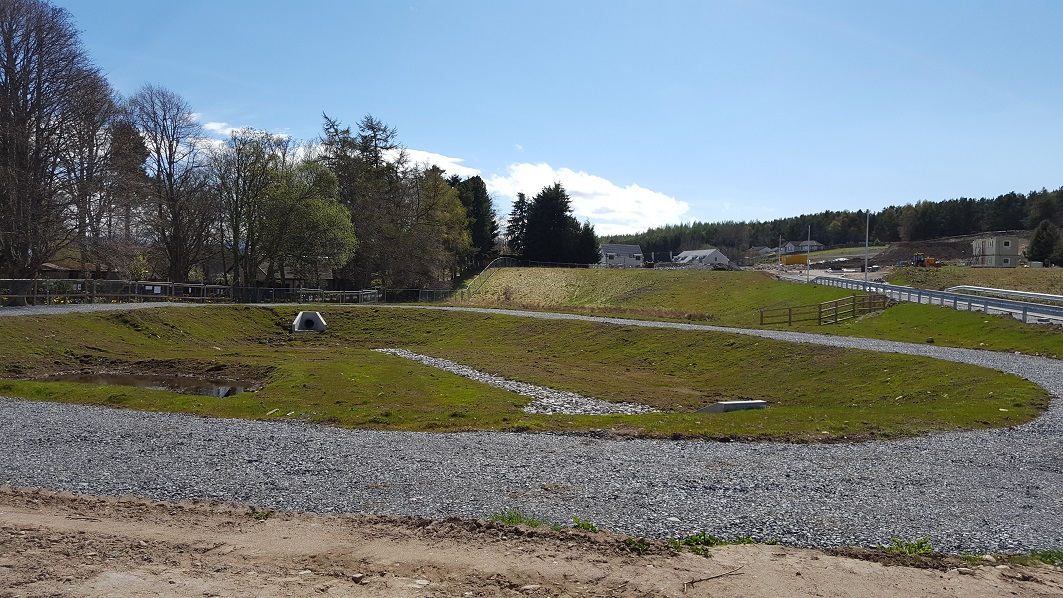
 Looks like many other SUDS schemes ….but why would they not want photographs taken?
Looks like many other SUDS schemes ….but why would they not want photographs taken?
Read on………………
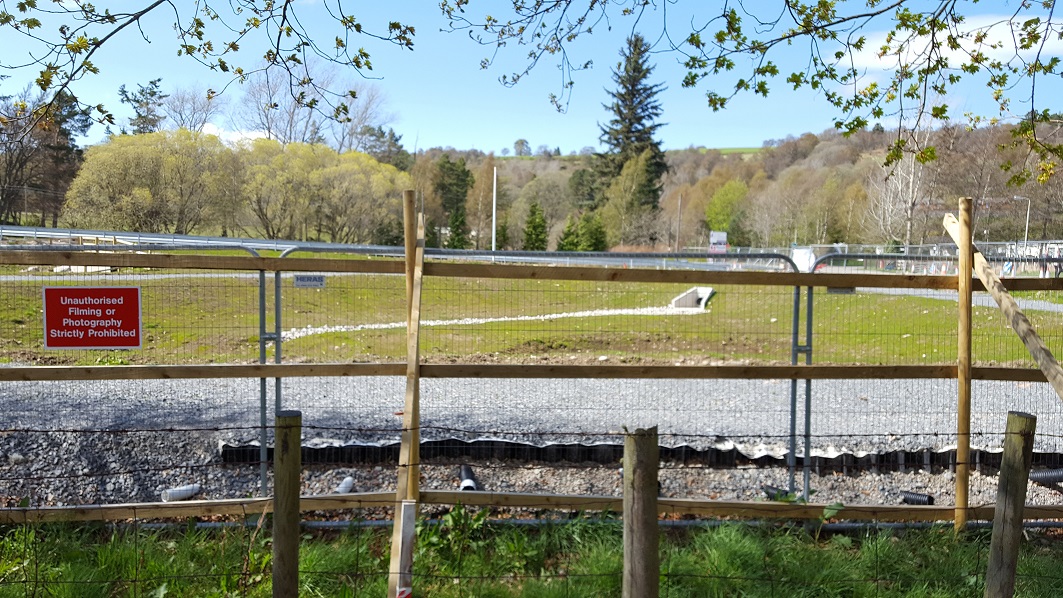
This SUDS scheme looks like many others, but could it really become a national icon and the ‘go to’ place for water technology as claimed by the British organiser of an Icelandic delegation visiting to the Cairngorms National Park? From my knowledge and professional experience of SUDS installations – and from living next door and seeing what has happened day to day – I don’t think so. Rather it presents a great example of how NOT to design and build such schemes.
Let me explain. SUDS stands for sustainable urban drainage system. For the last few decades it has become the standard way to manage storm water flows from industrial and residential developments. Instead of channeling the flash flows of storm water from concrete, tarmac and roofs into limited capacity closed drains, or just emptying flash flood water directly into rivers exacerbating flooding, ponds are created which hold flash flood water and manage the discharge into the river system.
On 26 April 2018 an Icelandic delegation on a water technology knowledge exchange visit to Scotland visited the SUDS scheme currently being installed on Beachen Court, a housing development under construction in Grantown-on-Spey. A video was posted on the Cairngorms National Park Authority Facebook page on 1 May 2018 (see here) which portrays this SUDS scheme as best practice but nothing could be further from the truth – instead there are important lessons for CNPA and developers to learn about avoiding the pitfalls into which this scheme has fallen.
In the article below I will deal with the main issues only.
Design Problems
These emanated mainly from bad or non-existent project management by the developer, and from Cairngorms National Park Authority planners operating what appeared to be such a ‘light touch’ approach that they did not pick up on or deal with the problems in a timely manner.
Design Problem 1
The initial engineering drawing submitted to CNPA around March 2016 in support of the planning application contained several serious design issues e.g. it proposed that a SUDS pond, capacity some 500m3 be located in the middle of the 1:4 slope of river terrace south of the floodplain – a ridiculous proposition:
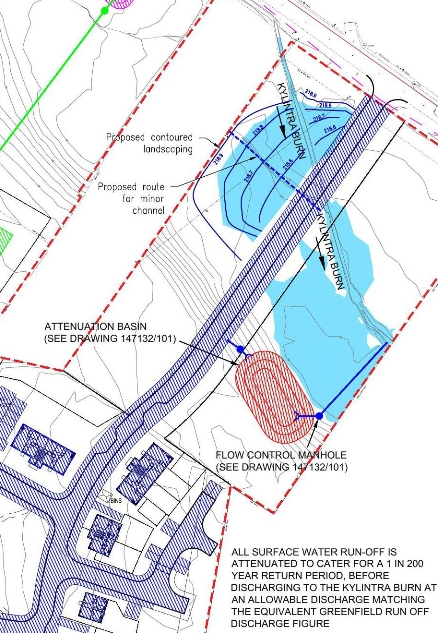
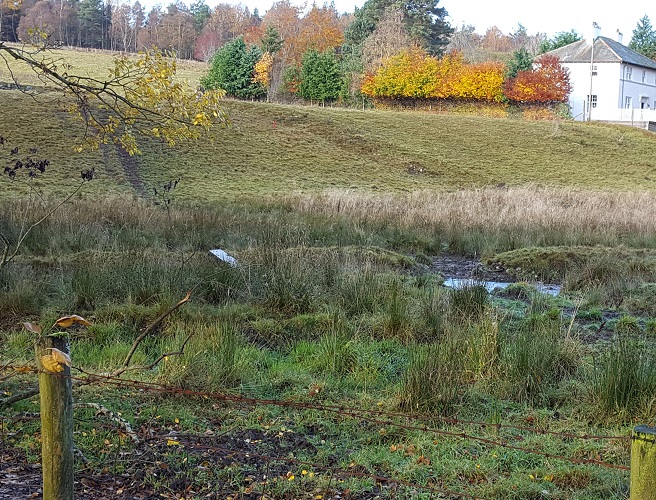
The dimensions of the proposed pond were also incorrect, far too small to provide the stated design capacity. OK, the design engineer made some dreadful mistakes but, just as concerning, when the developer submitted this drawing in support of his application the CNPA as Planning Authority, apparently without thought, put it out for public consultation. CNPA will say it’s not their job to question design when there is a statutory consultee to make comments but the faults with the pond were so obvious it would surely have been common sense for CNPA to address them before consultation and avoid wasting consultees’ time.
Design Problem 2
Following criticism on consultation the plan was amended to show the SUDS pond relocated onto the floodplain area of the Kylintra Burn. The size appeared to offer the design capacity and other errors were corrected. Statutory consultees seemed relatively content with the new design which was included in the planning application approved by the CNPA Planning Committee in October 2016, however significant problems remained e.g.:-
– The size and shape of the SUDS pond is highly constrained by the new access road to the west, Seafield Avenue to the north, the driveway of The Dulaig to the east and the flood plain of the Kylintra Burn to the south. There is no room for manoeuvre.

After planning permission had been granted it was discovered that the approved design completely ignored that the mature trees lining our driveway required a tree root protection area – up to 9 metres wide – which stretched into the development site. The design required the eastern embankment of the pond be built right over this tree root protection area.

The paper trail is a bit unclear but it appears that CNPA was certainly aware of the tree problem in late April 2017, just as development site work was commencing. Why was this problem not picked up earlier? In my opinion it was due to bad – or non-existent – project management and because the drawing showing the relocated SUDS pond was too schematic i.e. it shows the dimensions of the pond but not its position relative to the surrounding fixed structures. This is a learning point for the planners.
Design & Build Problem 3
Does the SUDS pond encroach on the area of flood plain required to cope with a 1 in 200 year flood (Plan 2 above)? The Developer’s Flood Risk Assessment says it does not, but I have serious doubts about this. In addition I have concerns that the as-built SUDS pond footprint, including embankments, is larger than the approved drawing and thus further encroaches on the already restricted flood plain.

Note that most of the SUDS pond footprint covers an area which had been long grass and rushes – an indicator of wetland – demonstrating it encroaches on the functioning flood plain
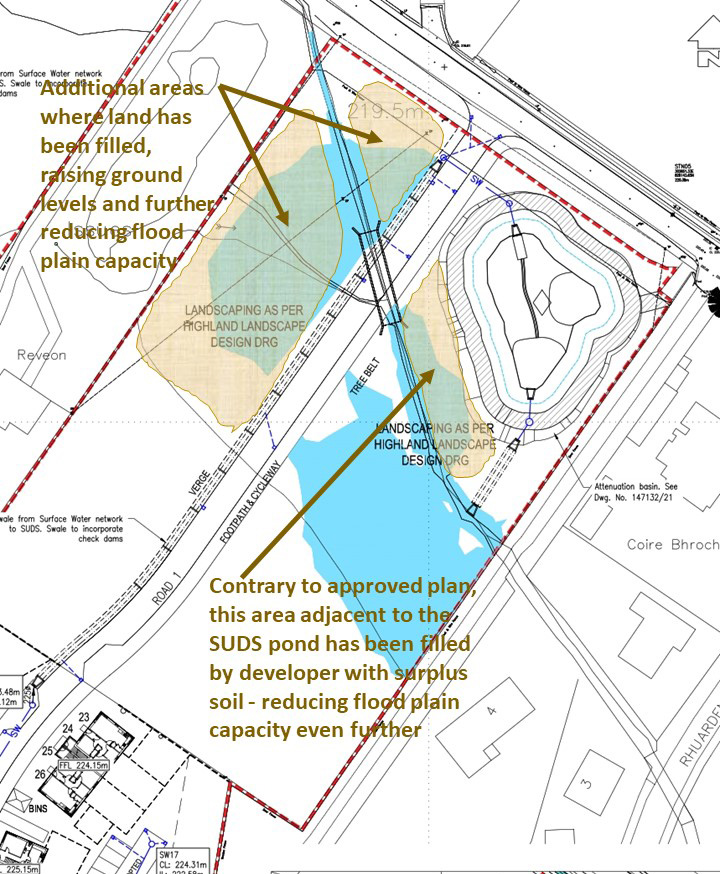
Note too the large areas of flood plain filled in on the opposite side of the new access road (illustrated in photos 10 and 11 below)
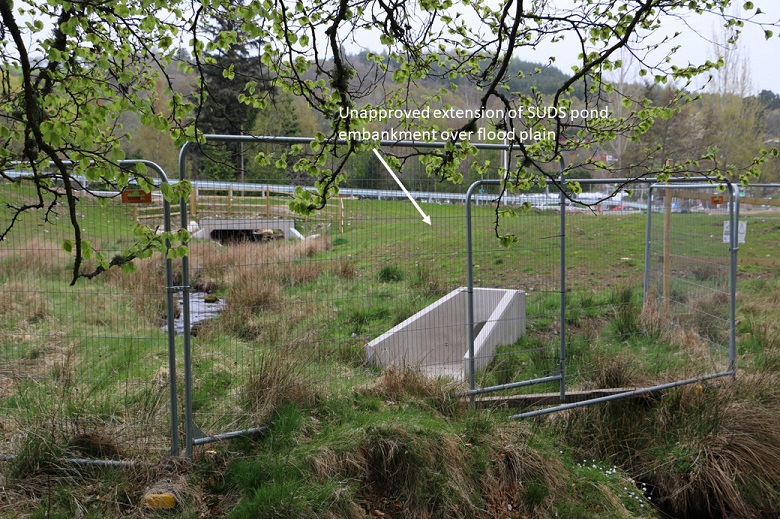
Edge of SUDS pond embankment sloping down to the Kylintra Burn. Compare this with Plan 4 which shows there should be at least 10 metres of flood plain between the embankment and the Burn.
Design & Build Problem 4
As shown at Plan 3 above, a 9-metre wide tree root protection zone was required adjacent to the SUDS pond to protect mature trees lining the drive of The Dulaig: these included a 100-year old beech tree and four sycamores over 30 year old. Despite me regularly asking CNPA planners how the conflict between the SUDS pond and the tree root protection area would be resolved, from late April to early June 2017 the developer was silent about the matter. On 13 June 2017 the developer sent an outline technical proposal to CNPA Planning and remarkably, without even consulting an independent tree expert, CNPA approved the controversial proposal on 14 June 2017. I was only informed of this after the event – there was no consultation with me despite my interest in the matter being well recognised by CNPA and my property being at risk from the solution.
So what was the approved technical solution? Well, a potentially excellent solution was available using Cellweb® to build the SUDS maintenance track over the roots of our trees (see http://www.geosyn.co.uk/product/cellweb-tree-root-protection for details). The expert design team Geosynthetics, the Cellweb® supplier, would have provided a free of charge bespoke design and, had the developer correctly constructed to that design, would have provided a 10-year warranty should any tree die. However, instead of working with Geosynthetics, the developer’s team came up with their own ‘Heath Robinson’ design which the supplier of Cellweb® would not warrant. Nevertheless CNPA still approved this unconventional design and within 24 hours.
What was wrong with the developer’s design & build? Here are just a few examples, ALL of which go against Geosynthetics expert installation advice, freely available on their website:
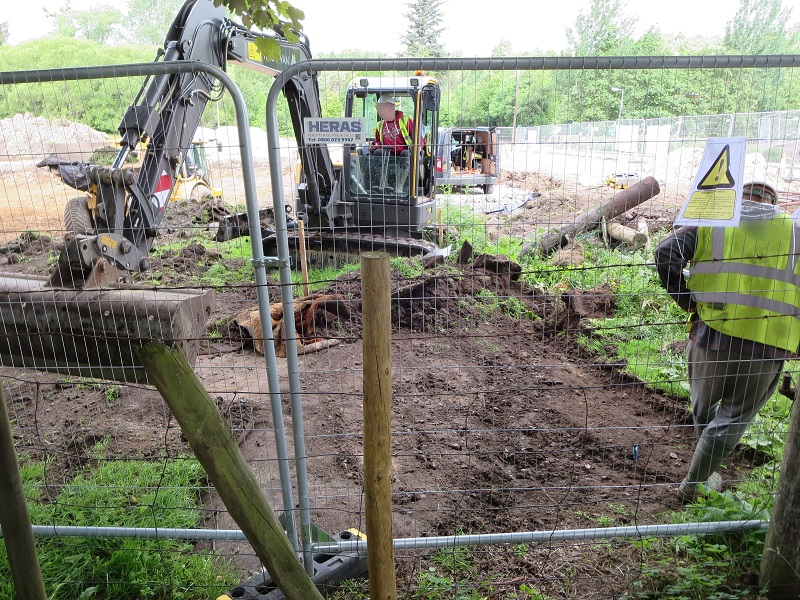
- Cellweb installation advice states “Soil compaction from vehicles, machinery and materials is to be strictly prohibited during construction within Root Protection Areas (RPAs).” and “Remove surface vegetation using hand held tools or a herbicide”. Instead surface vegetation was scraped off using a mechanical excavator, potentially damaging the fine roots the trees use for feeding.
- Cellweb installation advice states “Permeable surface is always recommended, if this is not possible approx.100mm thickness of subbase type 1 can be used as running surface”. Type 1 aggregate was used to varying depths up to 250mm to form the running surface.
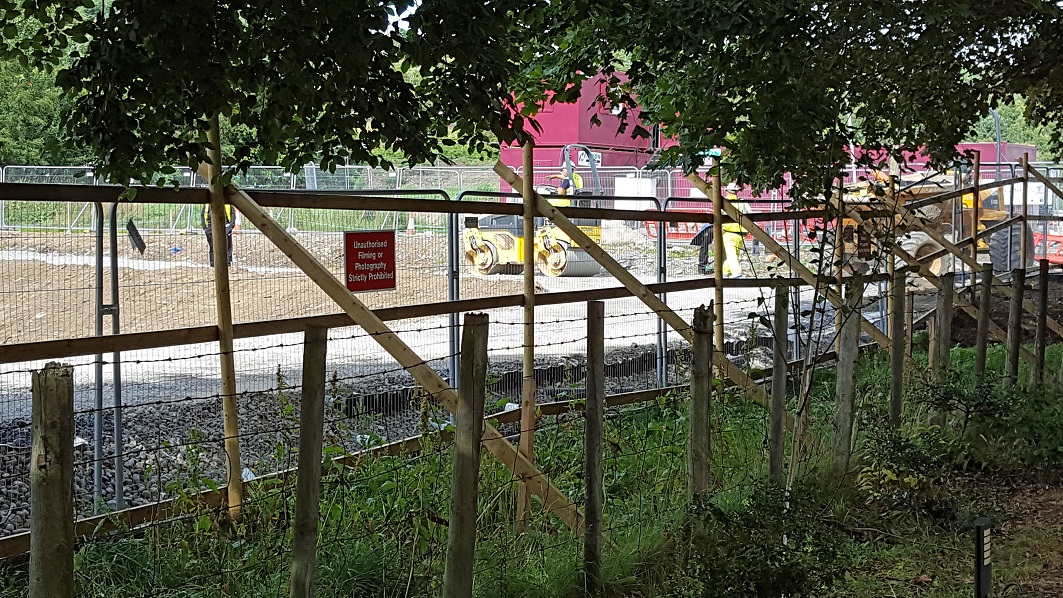
- Cellweb installation guidance states “Do not use a whacker plate… or any other form of compaction” but the Type 1 was compacted with a large vibratory roller (compacted Type 1 reduces oxygen supply to tree roots)

- A thick layer of topsoil was placed on top of part of the Cellweb® installation – reducing oxygen supply to the tree roots – negating the beneficial effect of the Cellweb®
We commissioned a well-respected independent arboriculturalist advise us on the design and build of the Cellweb® based track. His conclusions are:-
“Where professional advice has been given to the housing developer regarding tree protection this appears to have been followed in part but with significant modifications introduced during the performance of the works on site. Deviation from current nationally recognised guidance and manufacturers installation instructions coupled with weak planning enforcement has resulted in an inadequate protection for the trees at The Dulaig.”
It is now springtime 2018 and the trees are just coming into leaf – a worrying time for our threatened trees. It’s a bit early to assess the 100 year old beech, but one of the sycamores which was healthy a year ago is currently looking particularly stressed and is very slow in coming into leaf.
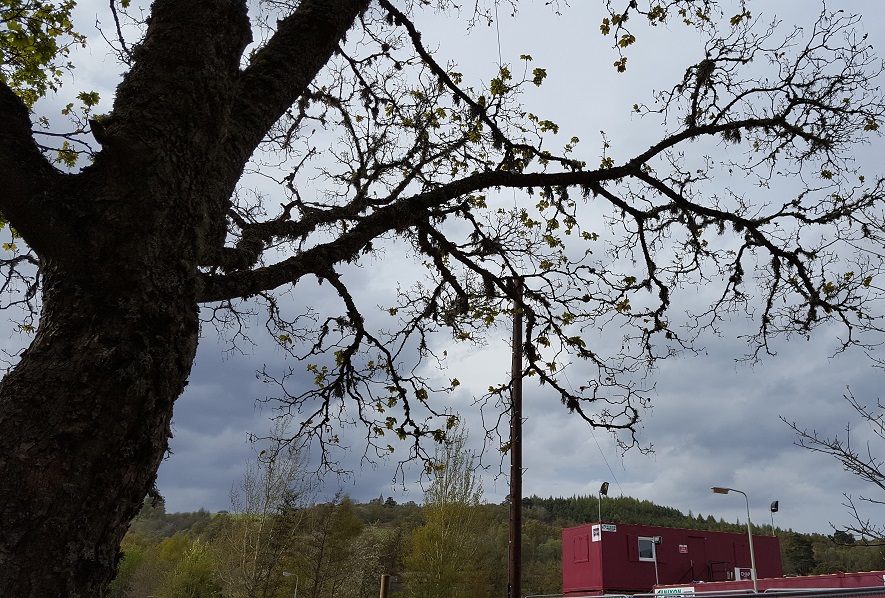
Neighbouring sycamores are almost in full leaf.
Habitat and Conservation Issues
In their Facebook video posted on 1 May 2018 The CNPA spokeswoman said “We really believe that if you have a good SUDS scheme within the development that it can really meet some of the aims we have to enhance landscape and bring biodiversity benefit”.
What her statement ignores is that the considerable earthworks within this low lying area of the development has unnecessarily destroyed much of the existing wetland and drier margins, greatly reducing the existing rich biodiversity. OK, a SUDS pond is required to manage storm water from the housing development, and a new access road with culvert had to be constructed, however well over 75% of the remaining grassland and wetland habitat has also been destroyed.
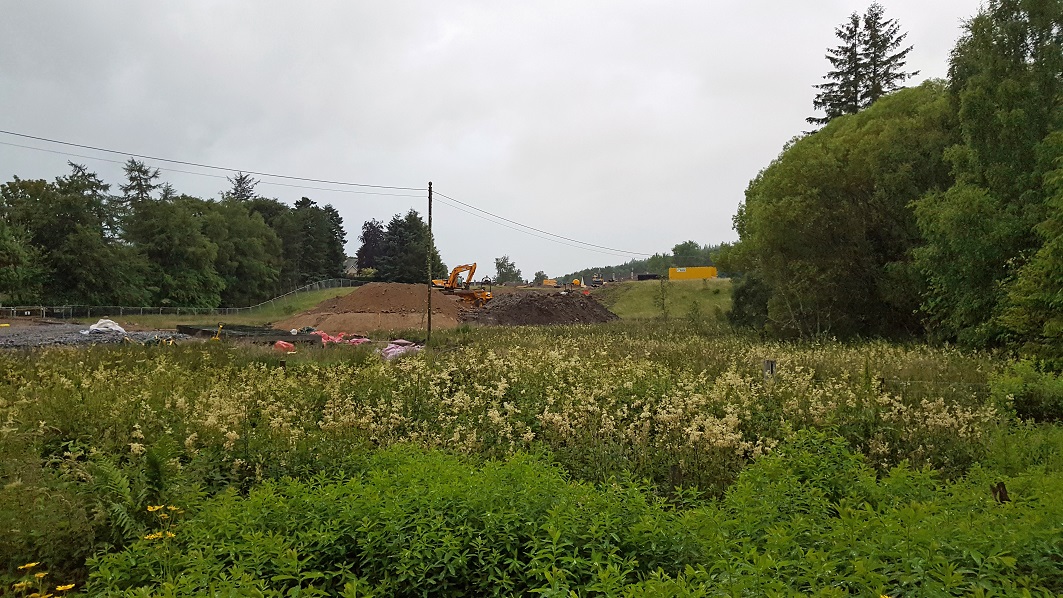
Meadowsweet rich wetland (July 2017) with access road construction underway to the left

The habitat in this low-lying flood plain area was diverse, some areas being wet marshy ground and other areas drier and only lightly grazed. The Kylintra burn supports otter, dipper, heron, salmonids, eels and brook lamprey. Toads were found in the varied grassland. The marsh had tall marsh vegetation with abundant flowers providing good habitat for pollinators, including marsh thistles, meadowsweet, angelica, valerian, ragged robin, greater bird’s-foot trefoil, spearwort, marsh marigold, water forget-me-not, rushes, grasses and willows. The planted grassland will not be as rich and varied as the marsh, nor provide all the habitat for invertebrates such as hoverflies, craneflies, hoppers and bumble bees that the marsh supported.
There are further unnecessary losses caused by storing and spreading surplus soil on the flower rich old river terrace that supported field gentian, insect-friendly plants such as birds-foot trefoil and especially devil’s bit scabious, as well as being a high interest for grassland fungi. An indication of the value of this area for pollinators such as bees is that mating conopid flies (thick headed flies) have been recorded on the site.
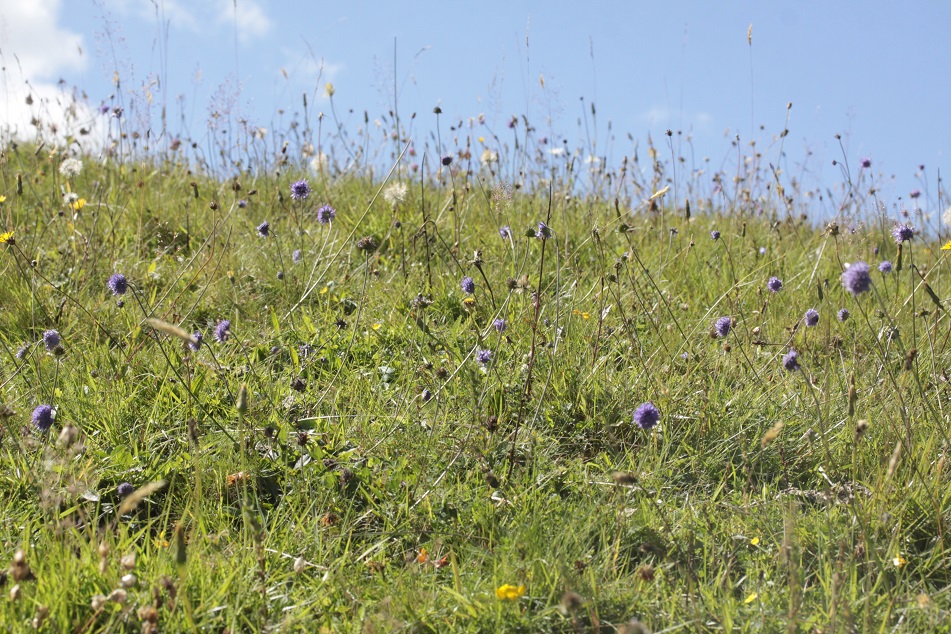
The CNPA spokeswoman on the Facebook video also stated, “…insects often overlooked within the National Park and other areas”. She is correct – and this is certainly one site where the insect biodiversity has been overlooked.


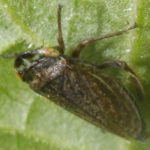
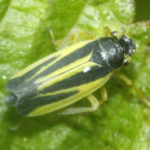
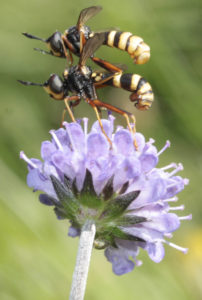
Just a few of the insects photographed on the site in 2016 prior to development work. (Pictures courtesy of BSCG)
A more sensitive developer and a more ecologically sensitive planning authority would have found ways of preserving much more of the former habitat. Most of the former wetland habitat and flora in this wetland area has been destroyed and currently only replaced by some kind of commercial meadow grass. Clearly biodiversity has been very much reduced and even with careful landscape management and planting will take decades to regenerate.
In summary, could this SUDS pond development become a national icon and the ‘go to’ place for water technology as claimed? Certainly not! Some organisations only learn by their mistakes, but in order to learn, they need to firstly acknowledge that major errors were made. Time will tell whether CNPA is open and objective enough to learn lessons or just continue to defend what they have permitted to be done.

Yes why are they so secretive about what is going on, what are they hiding? How can they stop you legally from taking photographs ? Can you be taken to court over this or is this just some heavy handed twerp trying to play the big brother.